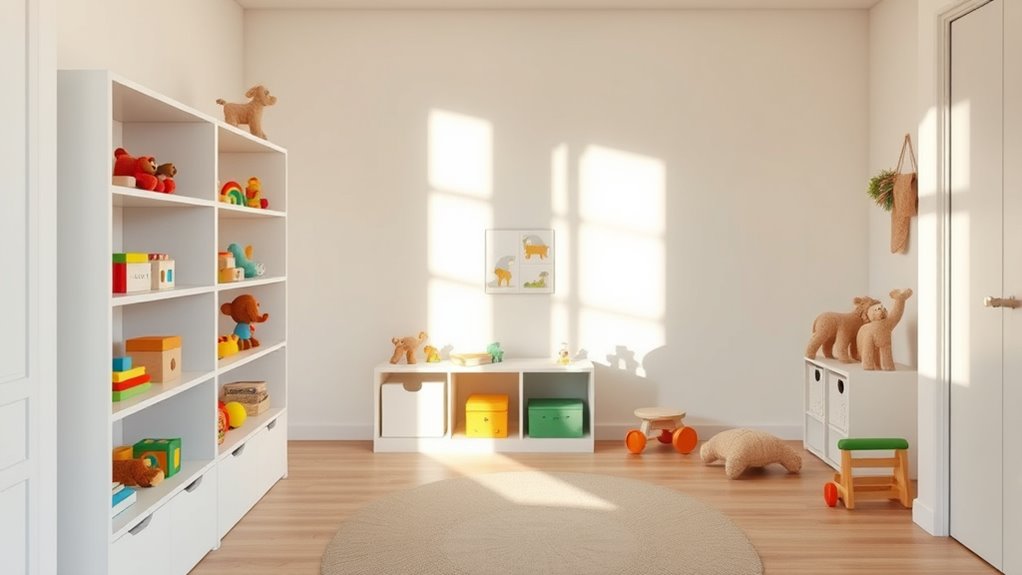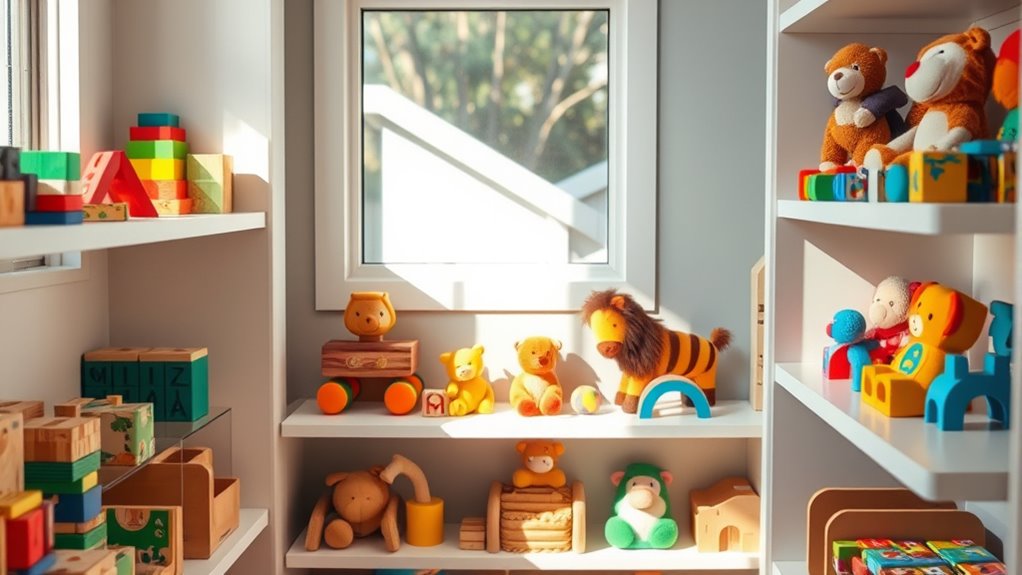Focusing on quality over quantity in toy rotation helps keep your child’s play meaningful and engaging. By selecting a few well-chosen toys and swapping them regularly, you foster exploration, creativity, and problem-solving skills. Organized storage keeps things simple and accessible, reducing clutter and overwhelming options. This approach encourages independence and responsibility while supporting your child’s development. Keep going, and you’ll discover how implementing thoughtful toy rotation can truly enhance their growth and playtime experience.
Key Takeaways
- Rotating toys enhances engagement and sparks creativity by providing fresh, interesting options regularly.
- Focusing on quality over quantity promotes meaningful play experiences that support cognitive development.
- Organized storage and strategic rotation prevent overwhelm and help children appreciate each toy’s value.
- Limiting toy choices encourages deeper exploration and problem-solving skills during play.
- Simplified toy management reduces clutter, making room for focused, developmental interactions.

Have you ever wondered how to keep your child’s toys fresh and engaging? Toy rotation is a simple yet powerful strategy to do just that. Instead of overwhelming your child with a mountain of toys, you select a handful to play with at a time. This approach not only maintains your child’s interest but also offers significant educational benefits. When toys are rotated regularly, your child is encouraged to explore different types of play, which can foster creativity, problem-solving, and cognitive development. It allows you to focus on quality over quantity, giving your child meaningful experiences with each toy rather than passively overwhelming them with endless options. Incorporating storage solutions that are easy to access and organize can make the process smoother and more effective. Effective storage solutions, such as clear plastic bins, labeled containers, or dedicated shelves, can help you keep track of which toys are in use and which are stored away. When it’s time to rotate, you simply swap out the toys, keeping the collection fresh and exciting. This not only reduces clutter but also teaches your child about organization and responsibility. As they learn to manage their toys, they develop fine motor skills and a sense of independence, all while appreciating the value of their possessions.
Frequently Asked Questions
How Does Toy Rotation Impact a Child’s Social Development?
Toy rotation encourages your child to engage more deeply with fewer toys, which enhances their social development. When they play with different toys, they’re more likely to participate in playdate interactions and practice sharing behaviors. This variety helps them develop better communication skills and understand others’ perspectives. As a result, your child becomes more confident and cooperative, fostering stronger friendships and improving their ability to navigate social situations effectively.
What Are the Signs a Child Is Bored With Current Toys?
You notice your child losing interest quickly, stacking toys without playing or ignoring their favorite ones. These boredom cues, like disinterest and lack of engagement indicators, suggest they’re ready for something new. For example, if your toddler no longer reacts excitedly to their usual puzzles, it’s a clear sign they’re bored. Switch up the toys to reignite their curiosity and keep their engagement indicators high, fostering development and learning.
How Often Should Toys Be Rotated for Optimal Benefits?
You should rotate toys every 2 to 3 weeks to keep your child’s interest fresh. Use toy shelf organization and storage solutions to make swapping easy and stress-free. Regular rotation prevents boredom and encourages development by introducing new challenges. Keep an eye on your child’s engagement, and if they seem uninterested, consider more frequent swaps. Consistent, thoughtful toy rotation enhances playtime quality and supports their learning journey.
Are There Specific Toys Better Suited for Rotation?
Think of toy rotation like planting a garden—you want diverse, vibrant blooms. Age-appropriate toys, especially those for sensory play, are perfect for rotation because they stimulate different senses and foster growth. Select toys that challenge and engage, such as textured balls, musical instruments, or puzzles. Rotating these keeps your child’s curiosity alive, helping them explore and learn through varied, enriching experiences that suit their developmental stage.
How Can Parents Introduce New Toys Without Overwhelming Children?
You can introduce new toys gradually through parental communication, explaining to your child why change is good and exciting. Start by rotating toys during playtime, making it clear that some toys are temporarily stored to reduce toy clutter management. This approach helps your child adapt without feeling overwhelmed. Keep the shift smooth by involving them in selecting and organizing toys, fostering understanding and enthusiasm for the new play options.
Conclusion
As you embrace toy rotation, you might find that less truly is more. It’s funny how, by simply swapping out toys, your child’s curiosity sparks unexpectedly and their focus deepens. Sometimes, just when you think a toy has lost its magic, a little break makes it feel brand new again. So, trust the process—you might discover that quality moments with fewer toys create the most lasting memories for developing minds.








